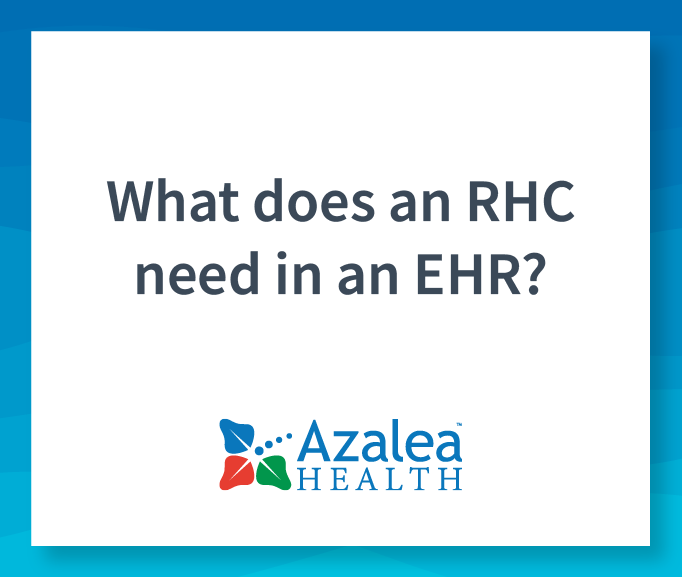RHC Webinar Series: What does an EHR for RHCs need?
Optimizing EHR Systems for Rural Health Clinics (RHCs)
- Specialized Reporting and Data Capture Capability: A critical function of an RHC’s EHR system is its ability to generate specialized reports and accurately capture vital data. This includes the tracking of bad debts, which is integral to financial management. Additionally, a robust EHR should provide tools for monitoring provider productivity visits, a crucial aspect of clinic administration.
- Streamlined Cost Reporting: To comply with financial reporting regulations, an RHC should have an EHR system that can effortlessly generate specific reports necessary for cost reporting. The capacity to directly extract these reports from the EHR system simplifies the process, minimizing manual work and ensuring precision in cost reporting.
- Handling Split Claims and Billing Codes: RHCs often encounter split claims and various billing codes, such as UB-04 and CMS-1500 forms. An efficient EHR system should facilitate the seamless management of these billing processes, enabling the separation of services provided under different P-10 numbers. This capability is crucial for accurate service tracking and optimization of reimbursement.
- Efficient Cost Reporting and Credit Balance Management: Streamlining cost reporting and credit balance management is essential for an RHC’s financial well-being. EHR systems should offer tools that simplify these processes, ensuring the accurate generation of all required reports and timely submissions to avoid penalties or reimbursement delays.
- Comprehensive Tracking of RHC Visits and Procedures: To enhance clinic productivity, an EHR system should allow RHCs to track visits and procedures based on procedure codes and providers. This level of granularity empowers clinics to assess productivity, identify areas for improvement, and tailor marketing efforts to specific patient demographics or geographic regions.
- Maximizing Reimbursement and Ensuring Compliance: A well-implemented EHR system can help RHCs maximize reimbursement by generating accurate reports and ensuring compliance with billing and reporting requirements. This not only safeguards the clinic’s financial health but also mitigates penalties and delays in fund disbursement.
Want to learn more?
Watch the full webinar on if you should become a rural health clinic and learn more about what Azalea does for rural health on our website.
Video Transcript
30:02 Let’s just spend a few minutes talking about what our EMR should have. As we talked about before, we need special reporting and data captive capture ability. We need to be able to capture a bad debt so that we can get those back. We need to have a provider productivity visit. There are certain reports and certain information that your accountant is going to need to file with the cost report.
27:44
We need to be able to get that information that, and it’s certainly much easier if we can pull it from our system.
27:53
We don’t have to do manual reports anymore. to keep up with that. We can just pull a report at the end of our cost reporting period hand that over to our accountant and he can plug in those numbers.
28:06
As we talked about earlier, we need to do split claims. We need to do UB four and we need to do 15 hundreds.
28:14
We need to have the ability to send. If were provider based, we need to be able to send under two different P 10 numbers, we need to send part underneath the R number.
28:27
For the actual A&M service, and then the diagnostic labs, and any diagnostic X-rays, or EKG, diagnostic part of those. We need to send them to the hospital Part B number. So, we need to be able to split those billings out.
28:44
Um, we need to simplify cost reporting and credit balance tools. We need the ability to effectively track RHC visits by procedure code by doctor. We want to make sure that we’re doing productivity that we can pull that out to see what’s happening within our clinic. I think it’s important to look at things like where patients are coming from. Let’s see where we need to do marketing effort. So, the more data that we can get out about our practice, the better it is, because the more efficient we can make our RHC operate and the better care we can provide for our community.
29:23
We need to avoid penalties and by doing X actual reports for maximum reimbursement.
29:33
That being said, you know, if a credit balance report is not filed over on the clinic side, it can hold up our money on our hospital side, if were provider based. So we want to make sure that we’re able to get all of this information done accurately the first time so that we are getting the maximum reimbursement that we should be receiving same way with their bad debts and are that we have. We want to make sure that we’re getting reimbursement for that.
Again, this will be a section that I know that you’ll want to join on, the analytics and the data capture, which will be the part four of our series.

